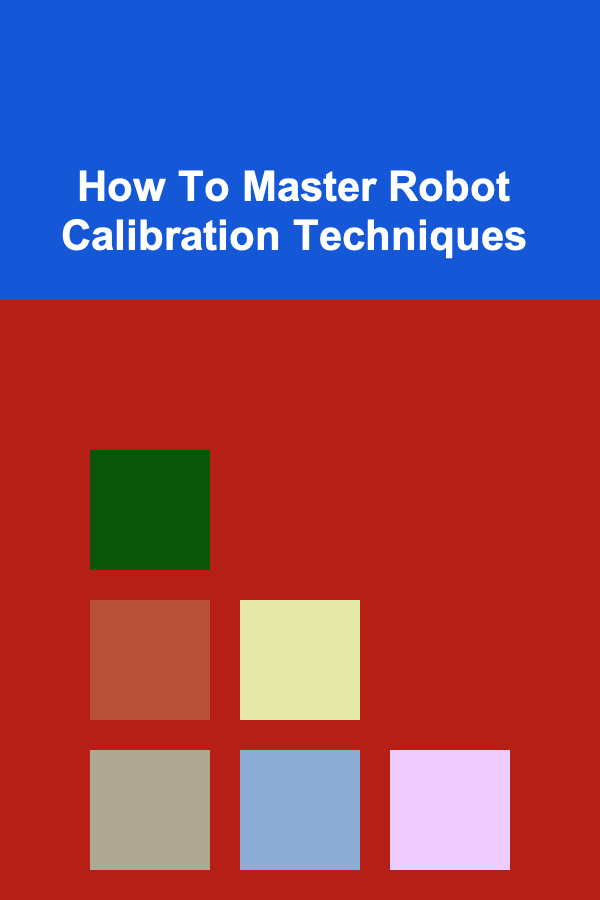
How To Master Robot Calibration Techniques
ebook include PDF & Audio bundle (Micro Guide)
$12.99$10.99
Limited Time Offer! Order within the next:

Robot calibration is a fundamental aspect of robotics engineering that ensures robots perform tasks with the required precision, reliability, and consistency. As automation continues to gain momentum across industries, the need for accurately calibrated robots has never been greater. Whether it's in manufacturing, healthcare, or research, robot calibration directly influences the efficiency, safety, and quality of tasks that robots are designed to perform.
In this article, we will explore the essentials of robot calibration, various techniques used to achieve it, and how to master these techniques to enhance the performance of robotic systems. We'll dive into the theory behind calibration, the process, common challenges faced during calibration, and the latest advancements in calibration technologies.
What is Robot Calibration?
Robot calibration refers to the process of adjusting and fine-tuning the mechanical and electronic components of a robot to ensure that it behaves in a predictable and accurate manner. Calibration involves setting the robot's sensors, actuators, and software systems to the correct parameters that enable it to perform tasks with high accuracy.
Calibration can be performed on various types of robots, including industrial robots, robotic arms, autonomous mobile robots, and service robots. Each robot type may have specific calibration requirements, but the core principles remain consistent.
Key Aspects of Robot Calibration:
- Kinematic Calibration: Adjusting the robot's joint parameters and link configurations to ensure the robot moves in the desired path.
- Sensor Calibration: Ensuring that sensors such as cameras, LIDAR, or force/torque sensors provide accurate readings by compensating for any biases or distortions.
- Actuator Calibration: Ensuring that the actuators (motors) of the robot operate according to the prescribed motions and force outputs.
The Importance of Robot Calibration
The importance of robot calibration cannot be overstated. A well-calibrated robot performs tasks with higher accuracy and reliability, which leads to improved outcomes in various applications. For instance, in manufacturing, even slight deviations from expected movements can cause defects in products, resulting in wasted materials, rework, and reduced throughput.
Furthermore, poorly calibrated robots can cause safety issues, especially in environments where humans work closely with robots. Accurate calibration ensures that robots avoid collisions, operate within safe parameters, and perform tasks with consistent reliability.
Here are some specific benefits of robot calibration:
- Enhanced Precision: Calibrated robots can perform tasks like assembly, painting, or packaging with fine precision, ensuring the consistency of production quality.
- Increased Efficiency: With proper calibration, robots can work at optimal speeds without compromising on accuracy, thus increasing overall productivity.
- Cost Reduction: By ensuring robots perform at their best, calibration reduces operational costs associated with errors, downtime, and maintenance.
- Safety Assurance: Properly calibrated robots are less likely to cause accidents, ensuring a safe working environment for human operators.
The Calibration Process
Calibration involves several key steps, from data collection to adjustments and validation. Understanding the process helps engineers select the right tools and techniques for calibration. Below, we break down the standard robot calibration process:
Step 1: Data Collection
The first step in calibration is gathering data related to the robot's current performance. This typically involves measuring various parameters, such as joint angles, positions, velocities, and forces. Advanced robots equipped with sensors can collect this data autonomously, but in some cases, manual measurements may be required.
Sensors like cameras or laser trackers are often used for precision measurements of position and orientation. Data collection is critical to identify the discrepancies between the robot's expected and actual performance.
Step 2: Modeling and Analysis
Once the data is collected, engineers use computational models to analyze the robot's kinematic and dynamic behaviors. This helps in identifying errors in the robot's configuration, such as geometric inaccuracies or actuator misalignment. Using software simulations, engineers can model the robot's movements and predict where adjustments are needed.
Step 3: Calibration Adjustments
After identifying the sources of error, adjustments are made to the robot's parameters. These adjustments may involve:
- Mechanical Adjustments: Realigning the robot's joints, recalibrating actuators, or correcting assembly errors in the robot's structure.
- Software Adjustments: Updating the robot's software to adjust for inaccuracies in sensor readings or motor control. This could involve tuning algorithms that handle inverse kinematics or motion planning.
- Sensor Compensation: Adjusting sensor readings to account for environmental factors like temperature, humidity, or mechanical wear that can distort sensor data.
Step 4: Validation
After making the necessary adjustments, the robot's performance is tested again to ensure that the calibration has been successful. Validation involves comparing the robot's actual performance to the expected results and ensuring that the discrepancies are within acceptable limits. If the performance is not up to standard, the calibration process may need to be repeated.
Common Calibration Techniques
Several techniques exist for calibrating robots, each suited to different types of robots and applications. Let's take a closer look at some of the most common techniques used in robot calibration.
1. Hand-Eye Calibration
Hand-eye calibration refers to the process of calibrating a robot's end-effector (the "hand") relative to the robot's vision system (the "eye"). In this technique, the robot's camera or vision system is used to track the position and orientation of the end-effector. This calibration is crucial for tasks like pick-and-place operations, where precise visual feedback is required.
Hand-eye calibration typically involves capturing images of the robot's end-effector in various positions and using these images to calculate the transformation between the robot's end-effector frame and the camera frame. The results of this calibration allow the robot to use vision feedback for more accurate task execution.
2. Machine Learning-Based Calibration
With the rise of machine learning, calibration techniques that utilize AI have gained popularity. Machine learning algorithms can analyze large datasets of robot performance, including sensor data, movement data, and real-time feedback, to identify calibration errors and make real-time adjustments.
Machine learning-based calibration allows robots to "learn" from past errors and adapt their behavior over time. For instance, robots can learn to optimize their movements based on sensor feedback, improving their performance without requiring constant manual intervention.
3. Coordinate Transformation Calibration
Coordinate transformation calibration is used to address discrepancies between different coordinate frames in a robot system. For example, the position of the robot's end-effector may be defined in one coordinate frame, but the robot's sensors may measure positions in a different frame.
This technique involves transforming the coordinates between different frames of reference to ensure that the robot's sensors and actuators align. Calibration algorithms can then be used to minimize errors in the transformation process, ensuring that the robot performs tasks accurately.
4. Force/Torque Sensor Calibration
For robots that perform tasks involving manipulation or interaction with the environment (such as industrial robots or robotic arms), force/torque sensor calibration is essential. These sensors measure the forces and torques applied to the robot's end-effector. However, like other sensors, they may have inherent biases or drift over time.
Force/torque sensor calibration involves applying known forces or torques to the sensor and adjusting its readings to ensure accuracy. This calibration process is vital for tasks like assembly, where precise force control is required.
Overcoming Challenges in Robot Calibration
While robot calibration techniques are powerful tools, they are not without challenges. Some of the most common challenges faced during calibration include:
1. Environmental Factors
Environmental conditions, such as temperature fluctuations, humidity, and vibration, can affect the robot's performance and calibration. For instance, changes in temperature can cause components like sensors and actuators to expand or contract, leading to inaccuracies. Calibrating robots in controlled environments is essential to minimize the impact of these factors.
2. Sensor Noise and Errors
Sensors often produce noisy data due to interference or mechanical wear. Noise can distort the accuracy of measurements and affect the quality of calibration. Engineers need to account for sensor noise during calibration by filtering out erroneous data or using advanced algorithms to mitigate the impact of noise.
3. Calibration of Complex Systems
As robots become more complex, with multiple sensors, actuators, and subsystems, calibration becomes increasingly difficult. For example, in collaborative robots (cobots), ensuring proper coordination between human and robot actions requires precise calibration of both the robot's sensors and its human interaction algorithms.
4. Non-Linearities and Dynamic Behavior
Many robots exhibit non-linear behavior due to factors such as joint friction, backlash, and other mechanical imperfections. These non-linearities can make calibration more challenging, as simple linear models may not capture the robot's full behavior. Advanced calibration methods, such as iterative learning and optimization techniques, can help address these challenges.
The Future of Robot Calibration
As robotics continues to evolve, the future of robot calibration holds exciting possibilities. Advances in AI, machine learning, and sensor technologies are paving the way for more autonomous and adaptive calibration methods.
1. Self-Calibrating Robots
The vision for the future is robots that can self-calibrate without human intervention. Using advanced sensors and machine learning algorithms, these robots would continuously monitor their performance, detect errors, and make real-time adjustments. This would reduce downtime and maintenance costs, making robots more autonomous.
2. Distributed Calibration Systems
In large-scale robotic systems, such as factories or warehouses, calibration could be distributed across multiple robots, with each robot sharing its calibration data to create a holistic view of the entire system. This would allow for more efficient calibration of multi-robot systems.
3. Integrated Calibration with Real-Time Feedback
The integration of real-time feedback systems will allow robots to adjust their calibration dynamically during operations. For instance, in manufacturing environments, robots could continuously adjust their calibration based on real-time sensor feedback, ensuring high precision throughout the production process.
Conclusion
Mastering robot calibration techniques is essential for achieving high performance, precision, and reliability in robotic systems. With the right tools, methods, and strategies, engineers can overcome the challenges of calibration and ensure that robots operate as intended, whether in manufacturing, healthcare, or service industries.
As technology advances, the future of robot calibration looks promising, with self-calibrating robots, machine learning-based methods, and real-time dynamic adjustments on the horizon. For engineers and developers working in robotics, mastering calibration techniques is not just a technical skill but a crucial aspect of ensuring the success and longevity of robotic systems.

How to Create a Family Game Day with Board Games
Read More
How to Store Appliances Properly When Not in Use
Read More
The Operations Supervisor's Toolkit: Essential Skills for Managing Day-to-Day Operations
Read More
How to TIG Weld Aluminum: A Beginner's Guide
Read More
How to Build a Bird-Friendly Aviary: A Checklist for Success
Read More
How to Analyze Your Alcohol and Tobacco Expenses for Insight
Read MoreOther Products

How to Create a Family Game Day with Board Games
Read More
How to Store Appliances Properly When Not in Use
Read More
The Operations Supervisor's Toolkit: Essential Skills for Managing Day-to-Day Operations
Read More
How to TIG Weld Aluminum: A Beginner's Guide
Read More
How to Build a Bird-Friendly Aviary: A Checklist for Success
Read More